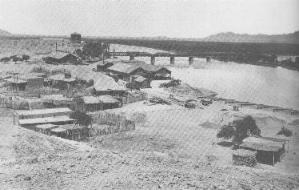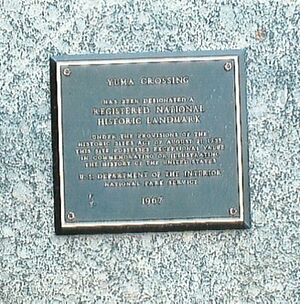Yuma Crossing facts for kids
|
Yuma Crossing and Associated Sites
|
|
 |
|
| Nearest city | Winterhaven, California and Yuma, Arizona |
|---|---|
| Area | 149 acres (60 ha) |
| Built | 1852 |
| NRHP reference No. | 66000197 |
Quick facts for kids Significant dates |
|
| Added to NRHP | November 13, 1966 |
| Designated NHL | November 13, 1966 |
The Yuma Crossing is a very important place in both Arizona and California. It's special because it was a key spot for travel and sending messages across the Colorado River. For a long time, it was the only easy place to cross the river for hundreds of miles.
This crossing helped connect different parts of New Spain (what is now Mexico and parts of the U.S.) and Las Californias (parts of California) when Spain ruled these lands. Later, it was vital during the Western expansion of the United States.
On the Arizona side, you can find the Yuma Quartermaster Depot and the Yuma Territorial Prison. On the California side, there's Fort Yuma, which was a fort that kept the area safe from 1850 to 1885.
Contents
A Look Back: History of Yuma Crossing
The story of the Yuma Crossing began with two huge granite rocks that made the Colorado River narrower. This narrow spot was the only easy place to cross the river for about a thousand miles! Because of this, it became a very important meeting place for early Native American tribes like the Patayan and later the Quechan.
In 1540, long before Europeans settled at Plymouth Rock, Spanish explorer Hernando de Alarcón arrived here. This marked the start of European history in Yuma. Later, in the 17th and 18th centuries, Spanish priests like Kino and Garcés explored the area.
After their explorations, the crossing became part of a route used by Spanish expeditions, including those led by Anza starting in 1774. This path, sometimes called the Sonora Road, connected the Spanish Tubac Presidio in Sonora (now part of Mexico) to Alta California (what is now California).
The Spanish tried to build missions and settlements near the crossing, but it didn't work out. The Quechan people, who had been friendly, became angry. They started a violent revolt that stopped the missions and settlements. This also closed the land route for a while. Later, in the 1820s, Mexican expeditions made peace with the Quechan, allowing the crossing and the Sonora Road to be used again.
Much later, the Yuma Crossing became a key point for travelers heading to the Wild West. This was especially true during the California Gold Rush in the 1840s. Its importance continued until the railroad arrived in 1877. Finally, the Ocean to Ocean Bridge was built, connecting the East and West coasts by land.
After the Mexican-American War in 1848, the U.S. Army built Fort Yuma here. Its job was to protect travelers from Native American raids. The fort was central to the Yuma War from 1850 to 1853. From 1864 to 1890, the fort and nearby areas were the main army base for controlling Native American groups in the greater Southwest.
Around the same time, the Butterfield Stage company set up a station here. This was a major stop on their stagecoach route from the east to California.
Because of its rich history, the Yuma Crossing was named a National Historic Landmark in 1966. It was officially called the Yuma Crossing and Associated Sites.
Yuma Crossing National Heritage Area
The Yuma Crossing National Heritage Area is a special place that helps protect and share the history of the Yuma Crossing. It's a U.S. National Heritage Area. For many years in the 18th and 19th centuries, this was the only place where non-Native American travelers could cross the lower Colorado River.
This Heritage Area is part of the Yuma Crossing and Associated Sites, which is listed on the National Register of Historic Places and is a National Historic Landmark. It spans both Arizona and California.
Like other U.S. National Heritage Areas, the Yuma Crossing National Heritage Area works with many different groups. These groups include Indian tribes, farmers, environmental groups, and many government agencies. They all work together to care for this important place.
Historic Parks and Sites
The Yuma Crossing National Heritage Area includes several interesting places. These are the Yuma Quartermaster Depot State Historic Park, the Yuma Territorial Prison, and Fort Yuma. These sites help show off the area's amazing history. They are located near the beautiful Yuma East and West Wetlands, with the Castle Dome, Chocolate (Arizona), and Chocolate (California) Mountains in the background.
The Heritage Area teaches visitors about Yuma's importance as a "cultural crossroads." This means it's a place where three major cultures have met and mixed: Anglo-American, Native American, and Hispanic-Latino. The Heritage Area believes that this rich mix of traditions can stay strong by being shown through art, music, food, and local customs.
Juan Bautista de Anza National Historic Trail
The Yuma Crossing is one of the important stops on the Juan Bautista de Anza National Historic Trail. This trail is part of the National Park Service and is a National Historic Trail in the United States. It's also part of the National Millennium Trail programs.
You can find brochures and maps online to learn more about the historic 1776 trail of Juan Bautista de Anza. There are also guides to historical places and events along the trail.
Protecting Nature: Habitat Restoration
The Yuma Heritage Area has been leading a big project to bring back the natural wetland and riverbank habitats in the East Wetlands. This project involves bringing back the flow of the Colorado River to these areas. It's a multi-year effort that costs millions of dollars.
In 2004, the Heritage Area partners got a special permit to start this restoration work. They have removed more than 200 acres (0.81 km2) of plants that didn't belong there and were harming the area. They have also replanted over 130 acres (0.53 km2) with native trees like cottonwood, willow, mesquite, native bunchgrasses, and palo verde trees. A one-mile (1.6 km) long back channel has also been dug, and about 20,000 new trees were planted in 2006.
So far, many different groups have given almost $6 million to this project. The total goal is to raise about $18–20 million to finish all the work.
Plants You Can Find Here
- Fremont cottonwood – Populus fremontii
- Catclaw Acacia – Acacia greggii
- Blue Palo Verde – Parkinsonia florida
- Velvet mesquite – Prosopis velutina
- Screwbean Mesquite – Prosopis pubescens – also called "Tornillo"
- Honey Mesquite – Prosopis glandulosa
- Goodding's black willow – Salix gooddingii
- Arroyo Willow – Salix lasiolepis




